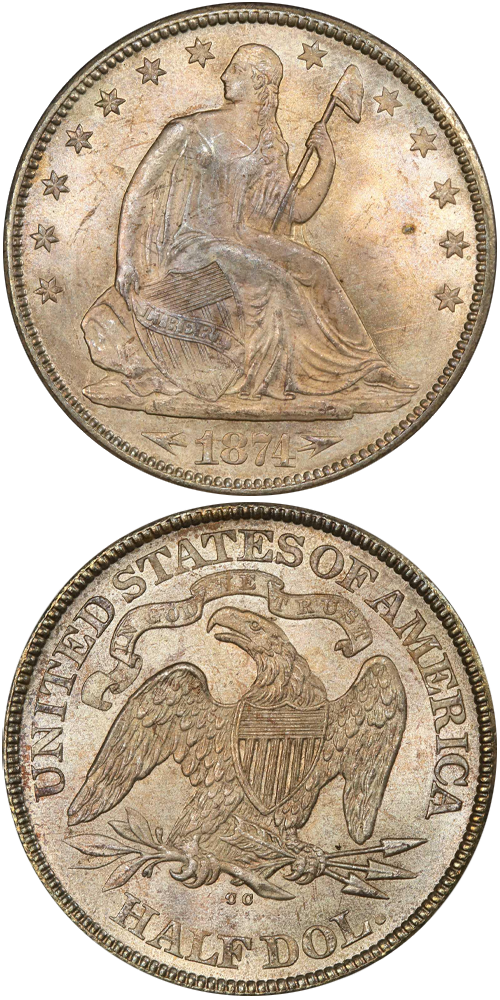1874-CC Liberty Seated Half Dollar
Arrows
Jeff Ambio: WB-3 is the early die state of the "Railroad Track Reverse" (WB-3a) variety of the 1874-CC half dollar, the former struck before the reverse die suffered prominent damage from the denticles through the letters TE in STATES. The obverse of the WB-3 marriage is identifiable by a pair of tiny die rust lumps, one on Liberty's right (facing) forearm below the lowermost curl of hair and the other in Liberty's lap. There is actually only one reverse die known for this issue, and it features a small CC mintmark. In the WB-3 die marriage the reverse exhibits a small raised defect (nicknamed "cowlick") on the back of the eagle's head. This defect is absent from coins struck from the earlier WB-1 and WB-2 die pairings, although a diagonal die line through the letters ES in STATES is present in all uses of this reverse.
Rusty Goe: Workers at the Carson City Mint did not concentrate on the production of small silver coinage in 1874, but instead turned their full attention to making trade dollars and to outputting more gold coins than in any other year of that factory's 1870-1874 run. They did not strike any quarter dollars in 1874. They recorded the lowest yield of ten-cent pieces in their mint's history. Even half dollars, which had previously led the way in per-piece production, tallied only a modest mintage of 59,000 -- the second lowest total between 1870 and 1878.
Regardless of the product turned out by mint employees, locals in Carson City derived great satisfaction from seeing signs of perpetual activity at the mint. When the Director of the Mint's annual report arrived in December 1874, the editor of the Carson Appeal scoured it for any complimentary information he could find about the branch in his town. In the December 13, 1874 edition, he steered his readers to the sections of the director's report "of special interest to us of Carson." He wrote, "It is natural that the dwellers in a town should be pleased with [the mint's] importance and distinction with regard to its chosen or natural specialty...."
As an example of the hometown pride engendered by the Carson Mint, the editor pointed out "the fact that as a place for handling silver bullion, Carson ranks first...." He went on to say that the local plant had made and issued more unparted silver bars than any other U.S. Mint facility during the fiscal year that had ended June 30, 1874. Furthermore, only the United States Assay Office in New York "outranked" the Carson Mint in the production of .999 fine silver bars. He ended his article by saying that all of these positive statistics in the director's report "cannot escape the observation of the most indifferent observer."
Q. David Bowers: Based upon his studies, Rusty Goe estimates that 120 to 150 1874-CC half dollars are known in all grades, of which perhaps 10 to 15 are Mint State and another 21 to 30 are in grades from EF to AU. In the context of demand for Carson City silver, this places all in the category of being key issues and higher level pieces as important rarities. Indeed, on the occasional instance in which a choice Mint State coin crosses the auction block there is always a lot of attention.
The example to the left was sold by Stack's Bowers Galleries in the D. Brent Pogue Part VII Sale, where it realized $84,000.






